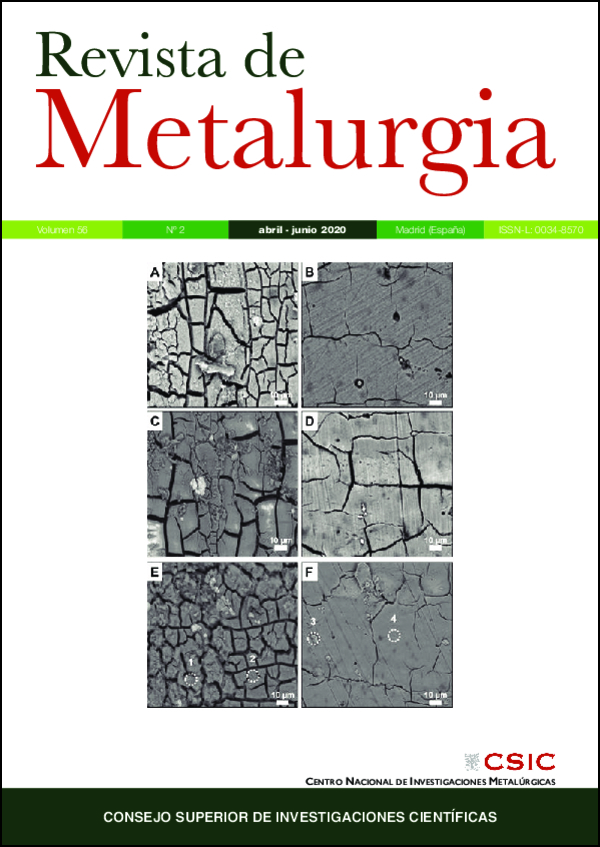Welding repair process of vanadium steel grooved rails and its validation by means of finite element modelization (FEM)
DOI:
https://doi.org/10.3989/revmetalm.168Keywords:
FCA weld, FEM, Rail, Tramway, Vanadium steel, WearAbstract
Arc welding repair procedures are widely used to increase the life service of grooved rails on trams. However, the new polymeric embedments used with these rails limit the temperature that can be achieved during the repair process, as these materials degrade when they are heated above 170 ºC. To avoid this problem, an optimum weld repair procedure must be developed to ensure an economically and fast weld without exceeding the limited temperature of the embedment. In this study, the repair of the new R290V rail steel (vanadium alloyed) was carried out with an austenitic stainless-steel consumable and a flux core arc welding technology (FCAW). The procedure was designed and validated using a finite element simulation and it was proved that it is possible to repair these rails without even attaining above 140 ºC in the embedment and without the formation of martensite.
Downloads
References
ArcelorMittal (2018). Grooved Rails for Tramways. Technical Manual. ArcelorMittal Europe Long Products. Rails & Special Sections. https://rails.arcelormittal.com/documentos/12-english/download.
Borck, R. (2019). Public transport and urban pollution. Reg. Sci. Urban. Econ. 77, 356-366. https://doi.org/10.1016/j.regsciurbeco.2019.06.005
Bullon, W., Acosta, J., Franco, R., Valverde, Q. (2007). Simulación de un proceso de soldadura mediante un modelo Termo-Mecánico considerando el efecto de esfuerzos residuales utilizando el Método de los Elementos Finitos. 8º Congreso Iberoamericano de Ingeniería Mecánica. http://congreso.pucp.edu.pe/cibim8/pdf/20/20-38.pdf.
Carrese, S., Gemma, A., La Spada, S. (2014). An emission model to compare bus and tramway transport. Procedia Soc. Behav. Sci. 111, 1025-1034. https://doi.org/10.1016/j.sbspro.2014.01.137
Carrol, R., Smith, H.M., Jaiswal, S. (2013). Rail steel with an excellent combination of wear properties and rolling contact fatigue resistance. U.S. Patent No 8430976.
Cho, S. (2018). 30 years working together solve Shangai's most pressing water problems. Worldbank. https://blogs.worldbank.org/water/30-years-working-together-solve-shanghai-s-most-pressing-water-problems.
ESAB (2019). Proceso de Soldadura FCAW - Alambre Tubular Relleno de Fundente. https://www.esab.com.ar/ar/sp/education/blog/proceso-soldadura-fcaw-alambre-tubular-relleno-de-fundente-definiciones-del-proceso.cfm.
Goldack, J., Chakravarti, A., Bibby, M. (1984). A new finite element model for welding heat sources. Metall. Trans. B 15 (2), 299-305. https://doi.org/10.1007/BF02667333
Goldaman, T., Gorham, R. (2006). Sustainable urban transport: Four innovative directions. Technol. Soc. 28 (1-2), 261-273. https://doi.org/10.1016/j.techsoc.2005.10.007
Marqueteeken, A., Van Leuven, A., Kopf, F. (2008). Cost effective track maintenance, renewal & refurbishment methods. Preventive maintenance of embedded tram tracks Rail wear in curves and special trackwork for trams. URBAN TRACK Project.
Martín, L., Calvo, F., Hermoso, A., De Oña, J. (2014). Analysis of light rail systems in Spain according to their type of funding. Procedia Soc. Behav. Sci. 162, 419-428. https://doi.org/10.1016/j.sbspro.2014.12.223
Martínez, E., Estrems, M., Miguel, V., Garrido, A., Guillén, J. A. (2009). Estado del arte de la modelización numérica de los procesos de soldadura por arco eléctrico empleados en construcción metálica. XIII Congreso Internacional de Ingeniería de Proyectos, Badajoz, pp. 8-10. https://www.aeipro.com/files/congresos/2009badajoz/ciip09_0460_0475.2486.pdf.
Pacyna, J. (2008). The microstructure and properties of the new bainitic rail steels. J. Achiev. Mater. Manuf. Eng. 28 (1), 19-22.
Rosenthal, D. (1946). The theory of moving sources of heat and its application of metal treatments. ASME, Vol. 68, pp. 849-866.
Rykalin, N.N., Nikolaev, A.V., Goronkov, O.A (1971). Calculation of current density in anode spot of arc. Teplofiz. Vys. Temp. (9), 981-985.
Sandor, T., Ramsey, J. (2012). Microstructure development in embedded tram rails due to ESAB cyclic surface welding technology without preheating. ESAB Global Market.
Sandor, T., Ramsey, J., Dumovic, M., Wiseman, R. (2013). Onsite repair welding of rails. Metals New Zealand.
Solano-Alvarez, W., Fernandez Gonzalez, L., Bhadeshia, H.K.D.H. (2019). The effect of vanadium on the wear resistance of pearlitic grooved rails. Wear 436-437, 203004. https://doi.org/10.1016/j.wear.2019.203004
TCRP (2012). Track design handbook for light rail transit. Second Edition, Report 155. Transportation Research Board, EEUU.
UNE-EN 14811 (2011). Aplicaciones ferroviarias. Carriles para fines especiales: construcción asociada y acanalada, AENOR. https://www.une.org/encuentra-tu-norma/busca-tu-norma/norma?c=N0046749.
UNE-EN 6507-1 (2018). Metallic Materials. Vickers hardness test, AENOR.
Vuorinen, E., Wang, L., Stanojevic, S., Prakash, B. (2009). Influence of retained austenite on rolling-sliding wear resistance of austempered silicon alloyed steel. International Conference on Hot Sheet Metal Forming of High-Performance Steel, pp. 339-347.
Westby, O. (1968). Temperature Distribution in the Workpiece by Welding. Dept. of Metallurgy and Metals Working, The Technical Univ. of Norway. PhD Dissertation.
Zahiri, R., Sundaramoorthy, R., Lysz, P., Subramanian, C. (2014). Hardfacing using ferro-alloy powder mixtures by submerged arc welding. Surf. Coat. Tech. 260, 220-229. https://doi.org/10.1016/j.surfcoat.2014.08.076
Published
How to Cite
Issue
Section
License
Copyright (c) 2020 Consejo Superior de Investigaciones Científicas (CSIC)

This work is licensed under a Creative Commons Attribution 4.0 International License.
© CSIC. Manuscripts published in both the printed and online versions of this Journal are the property of Consejo Superior de Investigaciones Científicas, and quoting this source is a requirement for any partial or full reproduction.All contents of this electronic edition, except where otherwise noted, are distributed under a “Creative Commons Attribution 4.0 International” (CC BY 4.0) License. You may read here the basic information and the legal text of the license. The indication of the CC BY 4.0 License must be expressly stated in this way when necessary.
Self-archiving in repositories, personal webpages or similar, of any version other than the published by the Editor, is not allowed.
















